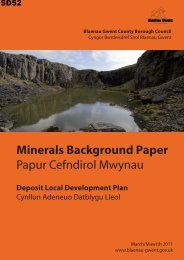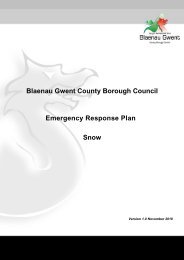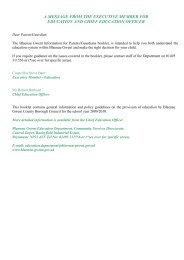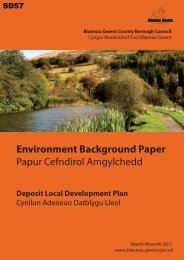Planning Policy Wales - Brecon Beacons National Park
Planning Policy Wales - Brecon Beacons National Park
Planning Policy Wales - Brecon Beacons National Park
You also want an ePaper? Increase the reach of your titles
YUMPU automatically turns print PDFs into web optimized ePapers that Google loves.
12.5 <strong>Planning</strong> to reduce and manage waste<br />
12.5.1 Local planning authorities are obliged by the EC Framework Directive on waste 8 to make<br />
provision for establishing an integrated and adequate network of waste disposal installations.<br />
They are also required, in conjunction with the Environment Agency which issues waste management<br />
licences and pollution control permits (see Chapter 13), to ensure that waste is recovered or<br />
disposed of without harming the environment, without endangering human health, without risk to<br />
water, air, soil, plants or animals, without causing a nuisance through noise or odours, and without<br />
adversely affecting the countryside or places of special interest, including areas of acknowledged<br />
importance in relation to the natural and cultural heritage.<br />
12.5.2 The Assembly Government’s general policy towards waste management is based on a<br />
hierarchy of reduction, re-use and material recovery (including recycling and composting), energy<br />
recovery with effective use of waste heat, and safe disposal. A sustainable approach to waste<br />
management will require greater emphasis on reduction, re-use and recovery and less reliance<br />
on disposal without recovery, and the consideration of the Best Practicable Environmental Option<br />
(BPEO) which is one of the key mechanisms used to guide waste management options. BPEO is site<br />
specific and subject to local circumstances. The technique can be supplemented by assessment of<br />
the most sustainable waste management option (SWMO), which incorporates social and economic<br />
impacts 9 .<br />
12.5.3 Waste should be managed (or disposed of) as close to the point of its generation as<br />
possible, in line with the proximity principle. This is to ensure, as far as is practicable, that waste is<br />
not exported to other regions. It also recognises that transportation of wastes can have significant<br />
environmental impacts. The waste hierarchy, the proximity principle and regional self-sufficiency<br />
should all be taken into account during the determination of the BPEO for the network of waste<br />
management installations that provides the best solution to meet environmental, social and economic<br />
needs.<br />
12.5.4 In <strong>Wales</strong>, the aim should be to provide sufficient facilities to treat, manage, or dispose of all<br />
the waste produced. Each local authority should consider what facilities are required to manage all<br />
waste streams generated within its area, although it may be necessary for some facilities (such as<br />
facilities for managing special or clinical waste) to be shared. Local authorities should co-operate<br />
through joint working arrangements 10 to produce regional waste plans in order to provide <strong>Wales</strong><br />
with an integrated and adequate framework or network of facilities that is actually achieved, thus<br />
meeting the requirements of the EC Directive. Local authorities should encourage any necessary<br />
movement of waste by rail and water rather than by road wherever economically feasible and have<br />
regard to the proximity principle.<br />
167<br />
<strong>Planning</strong> <strong>Policy</strong> <strong>Wales</strong> Edition 3 - July 2010 - Chapter 12 Infrastructure and Services















